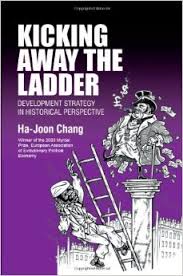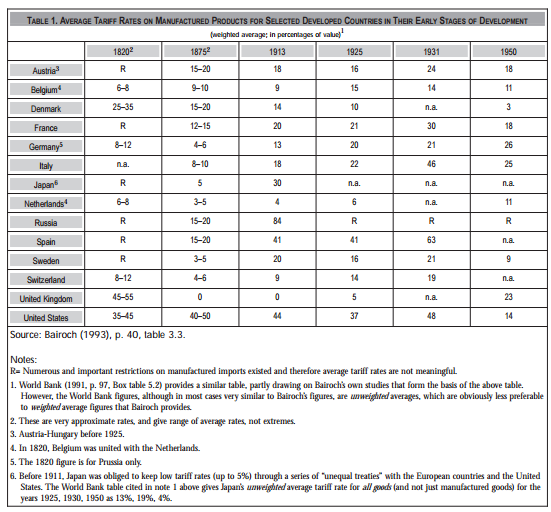 Developed countries stimulate developing countries to adopt the “good” institutions and “good” policies which will bring them economic growth and prosperity. These are promoted by institutions such as the WTO, the IMF and the World Bank. Recipes such as abolishing trade tariffs, an independent central bank and adhering to intellectual property rights feature high on their agendas.
Developed countries stimulate developing countries to adopt the “good” institutions and “good” policies which will bring them economic growth and prosperity. These are promoted by institutions such as the WTO, the IMF and the World Bank. Recipes such as abolishing trade tariffs, an independent central bank and adhering to intellectual property rights feature high on their agendas.
In his book “Kicking away the ladder” Ha-Joon Chang shows that these policies are not so beneficial for developing countries. Through historical analysis he shows that developed countries actively pursued all types of interventionist policies to achieve economic growth, contradicting the recipes they are now prescribing. A case of poachers turning into gatekeepers.
Policies that were intensively used by the USA and European countries include tariff protection, import and export bans, direct state involvement in key industries, refusal to adopt patent laws, R&D support, granting monopoly rights, smuggling and poaching expert workers. Chang points out that alleged free trade champions, the UK and USA, were the most protective of all and only switched to liberalisation after World War II when and as long as their hegemony was safe (see table below). Asian tigers such as South Korea and Taiwan did the same, which explains their success. Ha-Joon Chang shows that, in comparison, current developing countries offer relatively limited protection to their economies.

What does it imply for development cooperation? Developed countries often expect developing countries to adopt world-class institutions and policies in a nick of time. However, the path to these kinds of institutions for developed countries was a long and winding path, a slow process that took decades, with frequent reversals. We sometimes forget that universal suffrage was only achieved as recently as 1970 (in Canada) or 1971 (Switzerland). It took the USA until 1938 to ban child labour. Switzerland was notoriously late to adopt patent laws (explaining its success with pharmaceutical companies). Imposing world-class institutions or policies on developing countries can be harmful because they take a lot of human and financial resources, which may be better spent elsewhere. In fact, adopting such institutions and policies mainly benefits the developed countries, not the developing ones.
Ha Joon-Chang calls this practice of using successful strategies for economic development and then preventing other countries from applying the same strategy “kicking away the ladder”. The WTO negotiation rounds or regional trade agreements have a lot in common with the “unequal” treaties between colonisers and colonised countries.
Why is institutional development so slow? Are there no last-mover benefits? Chang gives following reasons:
- Institutional development is firmly linked with the state’s capacity to collect taxes. This capacity is linked to its ability to command political legitimacy and its capacity to organize the state (see blog post on Thinking like a State). That’s also another reason why tariffs are so important for developing countries: they are some of the taxes that are easiest to collect. Institutional development is linked to the development of human capacity within a country by its education system. Setting up “good” institutions in countries that don’t have the human capital for it will lead to undermining, bad functioning or draw away scarce resources from other sectors.
- Well-functioning institutions and policies need to fight initial resistance and prejudice. Chang points to the resistance to introducing an income tax at the beginning of the 20th century in western countries. It can take years and gradual policy changes to overcome this. The struggle to raise the retirement age in western countries is another illustration of the sometimes double standards we use toward developing countries.
- Many institutions are more the result of economic development rather than a condition for it. This is contentious, but Chang points to democracy as an example.
Chang advocates for developing countries to pursue an active interventionist economic policy. His thesis confirms the importance of supporting developing countries in the strengthening of their education systems. However, it also illustrates that the financial harm to developing countries as a result of unequal trade policies can be much higher than the aid flows to these countries.
 The beliefs that teachers and school leaders hold about education are arguably instrumental to their practice. These include beliefs about the purpose of education, beliefs about how people learn, beliefs about the nature of their subject (e.g.
The beliefs that teachers and school leaders hold about education are arguably instrumental to their practice. These include beliefs about the purpose of education, beliefs about how people learn, beliefs about the nature of their subject (e.g.  South Africa has made great strides towards achieving gender equality in education. According to the
South Africa has made great strides towards achieving gender equality in education. According to the  With Who Owns the Future, Jaron Lanier has delivered another wildly thought-provoking work of “speculative advocacy” after his 2010 work “You Are Not a Gadget”.
With Who Owns the Future, Jaron Lanier has delivered another wildly thought-provoking work of “speculative advocacy” after his 2010 work “You Are Not a Gadget”.